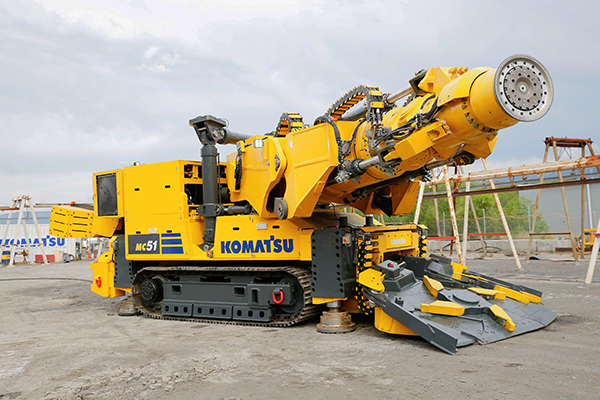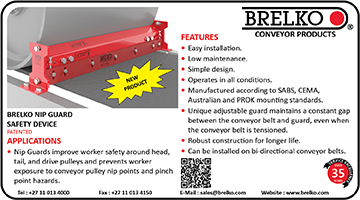In line with its diversification strategy, equipment manufacturer Komatsu will soon be introducing the Komatsu hard rock miner to local shores, which will springboard it into commodities beyond just coal to industrial minerals, potash and limestone.

Komatsu Mining Technologies (KMT) currently supplies Joy equipment primarily to the coal mining industry – an industry, which albeit robust, continues to face logistical headwinds stymieing export potential.
The new hard rock miner, which recently underwent trials at mining operations in Canada and Australia, will be launched officially at MINExpo INTERNATIONAL, the industry’s largest global mining event, which takes place at Las Vegas, in the US, from 24th to 26th September, KMT’s director for marketing sales and service, Ryan Gaylard, tells Modern Mining.
“This exciting venture signals an entry point into the hard rock mining segment and will open up a plethora of new opportunities for Komatsu, including the chance to apply learnings from the coal mining industry to the hard rock mining space and aid customers in improving efficiencies and reducing their cost per tonne.”
Over the past decade OEMs have been advancing rock cutting technology to ensure limited damage to underground mining areas being blasted.
“During the drilling and blasting process the surrounding rock and support structures are the most impacted. To mitigate this, miners employ equipment such as the continuous miner or a hard rock miner, to mine much more selectively. Komatsu’s latest hard rock miner, an ideal product for underground applications, is equipped with the latest technology making it extremely cost effective and highly efficient in selective mining.”
KMT will launch its new hard rock miner in South Africa before the end of the year, says Gaylard.
Coal conundrum on Komatsu business
While global requirements for coal remain strong, underpinned by demand from populous countries – including China, India and Europe – for cheap power solutions; the Paris Agreement’s call for reduced emissions and a lower carbon footprint and the local industry’s logistical challenges related to rail allocations on the Transnet line, remain a concern for miners.
“Although coal is abundant and a cheap source of fuel for power stations, the environmental impact of burning coal has become a key factor influencing the reduced appetite for fossil fuels by many countries. Furthermore, we have noted that several customers, both locally and internationally, have come under pressure from environmental groups. The good news, though, is that customers are increasingly investing in clean coal technology – a trend we expect to see grow in the medium to long-term.”
Given that some miners have been unable to secure rail freight allocation on the Transnet line, product earmarked for the export market is being stockpiled, with the knock-on effect being that equipment suppliers to the coal industry have been unable to grow their businesses, a key driver underpinning Komatsu’s diversification strategy.
Gaylard explains that the slow-down in production from South African coal mines translates to low demand for its machines, a reduced demand for equipment rebuilds and constrained demand for service and parts – all of which have stymied business growth for the equipment manufacturer.
“On the bright side, we are seeing an improvement in terms of increased rail allocation by the freight rail operator, Transnet. However, from a business point of view, we understand that it is more important than ever for us to improve our levels of efficiency and ensure that there is as little wastage as possible in our processes, both in terms of manufacturing as related to equipment rebuilds and our parts supply processes. As customers are extremely cost-conscious, we do not want to pass on unwarranted cost increases to them and are working together to implement processes, such as our smart service programme, to increase operational efficiencies and improve their production capabilities.”
Smart solutions
Moreover, with the mining sector, in particular coal mining, finding less favour with youngsters, the industry is facing a severe skills attrition, including in countries such as Australia, North America and India. The skills gap is further impacted by staff retirements.
It is against this backdrop that the equipment supplier’s smart solutions offering is fast gaining traction. According to Leon Papenfus: Manager – Smart Service, appetite for Komatsu’s smart service solutions has been phenomenal.
“We customise our smart solutions capabilities to meet customer requirements. For instance, in a training scenario, we engage with our customers about their training needs and limitations and follow up with an assessment of their skills set in the underground environment. We then customise a training programme for that specific company. Once we have upskilled the staff on aspects such as operating their equipment, we task our field service teams to address further shortcomings. Given that each mining operation has different requirements, operational challenges, needs and strategies, we offer each client a bespoke service.”
Further to this, Komatsu’s smart solutions offering integrates with its equipment to unlock opportunities related to the Internet of Things and big data to improve production efficiencies and ensure equipment operates at its peak.
“We use big data analytics to extract data from our underground machines (collated on the global analytical platform) for insight into real time activities and functioning of the equipment, including technical reliability of the machines and service considerations, amongst others. Our field service support and asset management teams use the information gleaned to advise customers on how to maximise aspects related to efficiencies and equipment health,” explains Papenfus.
Aligned with Komatsu’s smart solutions offering is its Good to Excellent offering, initiated last year, which sees KMT partnering with clients to increase their production targets and unlock efficiencies in their process to achieve a lower cost per tonne.
“We work closely with our customers to understand their mining operations, their limitations and the production targets they wish to achieve. An intensive due diligence is undertaken on their operation in line with the stated objectives of production and efficiency targets. In fact, last year we had four customers who took up our offering – the million-milestone production programme – which helped miners achieve a target of a million tonnes per annum from a particular section of their operation.”
Following these phenomenal achievements, existing customers and several new customers have signalled their eagerness to improve their current production capabilities and have partnered with Komatsu to identify sections of their operations they wish to ramp up.
“It is important to note that not all operations have orebodies that are able to deliver an output of a million tonnes per annum. Despite our best interventions, some mines will just not be able to achieve a million tonnes per annum; however, with improved efficiencies, we may be able to achieve an end goal of half a million tonnes per annum. Customers are also partnering with us to achieve a target of half a million tonnes per section,” adds Papenfus.
Further to this, Komatsu has been testing the Continuous Miner assistant programme which is similar to “cruise control” on a vehicle, to help the operator with cutting cycles. Essentially, the programme reduces the number of inputs required from the operator and, in turn, reduces the strain on the operator and frees him or her up to focus on safety, better controlling and observing the overall mining process.
“Simultaneously controlling the cutting cycles and keeping an eye on the path ahead can be difficult as it requires constant concentration, which often results in fatigue. Moreover, irregular surfaces, caused by varying roof and floor control, and over and under sumping cause uneven shuttle car loading, spillage, and fines. Unplanned time delays and irregular path patterns are also factors that hinder efficiency and escalate to added costs and additional maintenance of other support vehicles,” explains Papenfus.
The Continuous Miner assistant programme promotes safety, ensures predictable cutting cycles, even surfaces and efficient shuttle-car loading. During normal operation, the operator navigates and controls the machine’s cutting cycles using the remote control.
“Komatsu’s innovations and technologies help our customers unlock value from their equipment to reach their stated production targets while ensuring that the equipment itself operates at peak performance,” concludes Gaylard.










